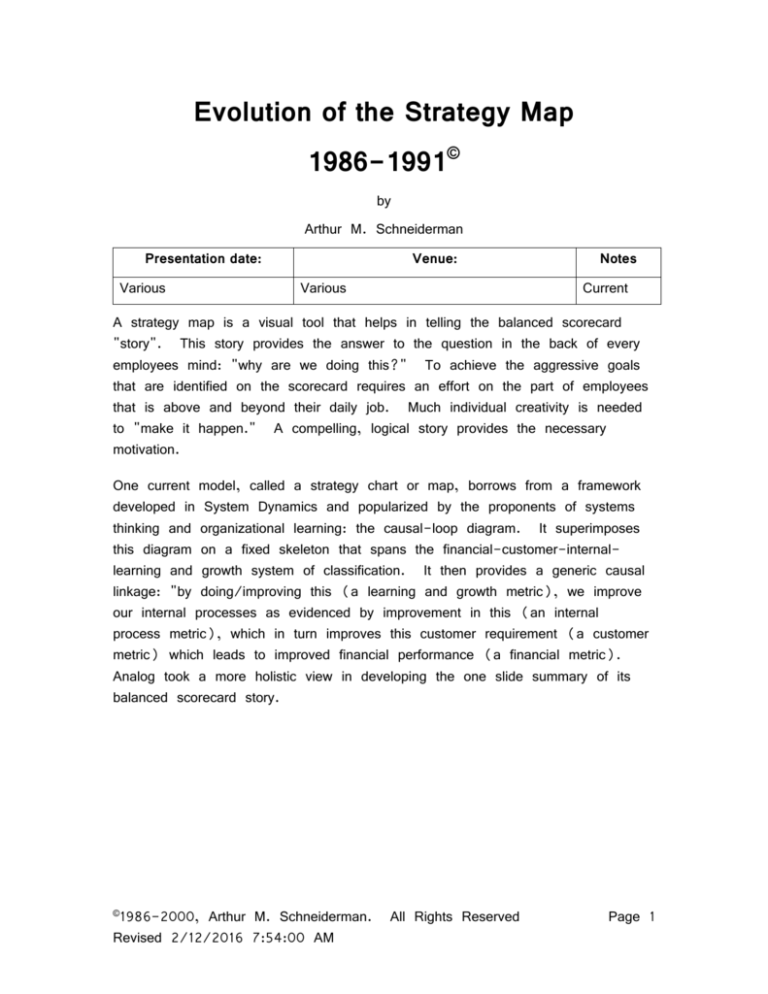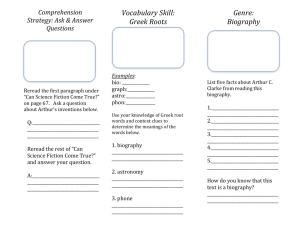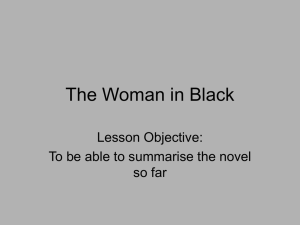
Evolution of the Strategy Map
1986-1991©
by
Arthur M. Schneiderman
Presentation date:
Various
Venue:
Various
Notes
Current
A strategy map is a visual tool that helps in telling the balanced scorecard
"story". This story provides the answer to the question in the back of every
employees mind: "why are we doing this?" To achieve the aggressive goals
that are identified on the scorecard requires an effort on the part of employees
that is above and beyond their daily job. Much individual creativity is needed
to "make it happen." A compelling, logical story provides the necessary
motivation.
One current model, called a strategy chart or map, borrows from a framework
developed in System Dynamics and popularized by the proponents of systems
thinking and organizational learning: the causal-loop diagram. It superimposes
this diagram on a fixed skeleton that spans the financial-customer-internallearning and growth system of classification. It then provides a generic causal
linkage: "by doing/improving this (a learning and growth metric), we improve
our internal processes as evidenced by improvement in this (an internal
process metric), which in turn improves this customer requirement (a customer
metric) which leads to improved financial performance (a financial metric).
Analog took a more holistic view in developing the one slide summary of its
balanced scorecard story.
©1986-2000,
Arthur M. Schneiderman.
Revised 2/12/2016 7:54:00 AM
All Rights Reserved
Page 1
Evolution of the Analog Devices Strategy Map: 1986-1991
Slide 1
Evolution of the
Analog Devices Strategy M ap
(1986-1991)
©1986-2000 Arthur M . Schneiderman All Rights Reserved.
©1986-2000,
Arthur M. Schneiderman.
Revised 2/12/2016 7:54:00 AM
Slide 1
All Rights Reserved
Strategy M ap
Page 2
Evolution of the Analog Devices Strategy Map: 1986-1991
Slide 2
ANALOG
DEV IC ES
FACILITY:
TEXAS INSTRUMENTS, HIJI, JAPAN
4" wafer fab and assembly of bipolar IC's
built 1974, 1300 employees
OVERALL GOAL:
(1980)
RESULTS:
"..to have our products rated #1 in quality by
more than 50% of our customers by 1985.."
defect levels reduced to 20 PPM (WSJ, 10/3/86)
average unit cost down by factor of 7
% customers rating them #1 in 1985:
linear products
45%
TTL products
60%
WINNERS OF 1985 DEMING PRIZE
"We've gone as far as we can in manufacturing. We are
focusing on IC design for further defect reduction."
Kimio Nonaka, Manager of TQC
©1986-2000 Arthur M . Schneiderman All Rights Reserved.
Slide 2
c. 10/10/86-Q IP-2
c. October 10, 1986
Analog's tool for telling the scorecard story originated in 1986; upon my return
form Juran's Impro 86. I was inspired by a booth and presentation given by
Texas Instruments' Hiji Japan wafer fab. I summarized their story on this
single slide.
©1986-2000,
Arthur M. Schneiderman.
Revised 2/12/2016 7:54:00 AM
All Rights Reserved
Page 3
Evolution of the Analog Devices Strategy Map: 1986-1991
Slide 3
ADI Wilmington Plant
Plant:
Fab (4” & 6” ) and assembly of IC’s
Built: various
1000 Employees
1987:
O verall Goal: “ Have our products rated number one
in Total value by more than 50% of our customers
–performance
–price
–quality/reliability
–delivery
–support
–responsiveness
–cooperativeness/partnershipness
•
•
•
•
1992:
Winner of the 1992 _____ Q uality Award
©1986-2000 Arthur M . Schneiderman All Rights Reserved.
Slide 3
c. 10/14/86
From a hand drawn slide presented October 14, 1986.
I created this fictitious version were I adapted the original to Analog's largest,
and a strikingly similar, wafer fab. The message was clear: here's a possible
future state for Analog, and ... someone's already there. This instantly
reduced my proposal from a consultant’s pipedream to a realistic possibility.
The excitement that these two slides produced, prompted me to create a third
version that applied to Analog's IC operations in total.
©1986-2000,
Arthur M. Schneiderman.
Revised 2/12/2016 7:54:00 AM
All Rights Reserved
Page 4
Evolution of the Analog Devices Strategy Map: 1986-1991
Slide 4
ADI Q IP Goals
1992
To be rated #1 by our customers by achieving
< 10 PPM defect levels
>99.8% on time delivery
< 3 weeks lead time
< 20 weeks product design cycle times
< 3 wks mfg cycle times
Reduction in WIP by x25
Reduction in changeover times by x250
Plus having the best prices/costs and performance
©1986-2000 Arthur M . Schneiderman All Rights Reserved.
Slide 4
c.10/14/86-
From hand drawn slide presented October 14, 1986.
We understood that the key to our strategic success was to be the vendor of
choice to our customers; to be number one on their list of favored suppliers.
But how do we get there and stay there? This was our fledgling attempt to
answer that question.
Over the next few weeks, this slide evolved into a two slide version: the first
describing what was possible by 1992 (which I called the External
Perspective), and the second one addressing how we could do it (which I
called the Internal Perspective). The combination of possibilities, the resulting
opportunities, and the required framework served as the basis for this early
story.
©1986-2000,
Arthur M. Schneiderman.
Revised 2/12/2016 7:54:00 AM
All Rights Reserved
Page 5
Evolution of the Analog Devices Strategy Map: 1986-1991
Slide 5
ADI 1992 QIP GOALS
EXTERNAL PERSPECTIVE
To have our products rated #1 in
TOTAL VALUE
by more than 50% of our customers
based on:
right products
performance
price
quality/reliability
lead time
delivery
support
responsiveness
cooperativeness
willingness to form partnership
©1986-2000 Arthur M . Schneiderman All Rights Reserved.
Slide 5
c. 10/28/86-Q IP-7
c. October 28, 1986.
This and the following slide resulted from the meeting of 10/14/86 between
Ray, Jerry and me, and incorporates our improvement of the previous two
strawman proposal slides.
The external perspective is the way that ADI appears to its customers. It is
the way that they would describe us if they were asked to give a reference.
All of these attributes are measurable by the customer.
©1986-2000,
Arthur M. Schneiderman.
Revised 2/12/2016 7:54:00 AM
All Rights Reserved
Page 6
Evolution of the Analog Devices Strategy Map: 1986-1991
Slide 6
ADI 1992 QIP GOALS
INTERNAL PERSPECTIVE
To constantly strive for the elimination of all
FORMS OF WASTE
at all entities, functions and levels within ADI
Manufacturing and Design
Other Areas
< 10 PPM defect levels
timely financial reporting
>99.8% on time delivery
reduced turnover
<3 weeks lead time
effective meetings
<3 weeks mfg. cycle time
actionable information
<20 weeks design cycle
perfect safety records
25X reduction in active WIP
250X reduction in changeover times
©1986-2000 Arthur M . Schneiderman All Rights Reserved.
Slide 6
c. 10/28/86-Q IP-8
c. October 28, 1986.
The internal perspective identifies the means that were required to achieve the
results of the previous slide.
©1986-2000,
Arthur M. Schneiderman.
Revised 2/12/2016 7:54:00 AM
All Rights Reserved
Page 7
Evolution of the Analog Devices Strategy Map: 1986-1991
Slide 7
ADI 1992 QIP GOALS
EXTERNAL PERSPECTIVE
To have our products rated #1 in
TOTAL VALUE
by more than 50% of our customers
based on:
right products
performance
features
price
quality/reliability
willingness to
form partnership
lead time
delivery
support
responsiveness
cooperativeness
safety
operating cost
maintenance cost
expected life
resale value
durability
serviceability
reputation
understanding
aesthetics
©1986-2000 Arthur M . Schneiderman All Rights Reserved.
Slide 7
c. 10/28/86-Q IP-7
rev. c. 7/31/87
As the scorecard story was told, more customer purchase criteria were
identified. To facilitate buy-in, I classified all suggestions as current or future
and added them to the list. I postponed the culling process to some future
date when we had achieved broader consensus.
©1986-2000,
Arthur M. Schneiderman.
Revised 2/12/2016 7:54:00 AM
All Rights Reserved
Page 8
Evolution of the Analog Devices Strategy Map: 1986-1991
Slide 8
ADI Q IP GO ALS
BUSINESS
OBJECTIVES:
MARKET LEADERSHIP (RMS)
REVENUE GROWTH
PROFITABILITY
DRIVERS:
BE RATED #1 BY OUR CUSTOMERS
IN TOTAL VALUE DELIVERED
EXTERNAL LEVERS:
PRODUCTS
DEFECT LEVELS
ON TIME DELIVERY
LEADTIME
INTERNAL LEVERS:
TIME TO MARKET
PROCESS PPM
MANUFACTURING CYCLE TIME
YIELD
©1986-2000 Arthur M . Schneiderman All Rights Reserved.
Slide 8
c. 1/17/89- AM S_5
In January of 1989, I combined the previous two slides onto a single slide,
pared the drivers down to the vital few and added the three business
objectives.
©1986-2000,
Arthur M. Schneiderman.
Revised 2/12/2016 7:54:00 AM
All Rights Reserved
Page 9
Evolution of the Analog Devices Strategy Map: 1986-1991
Slide 9
By April of 1990, the external perspective had to be broadened to include the
newly emerging requirements of price and responsiveness.
©1986-2000,
Arthur M. Schneiderman.
Revised 2/12/2016 7:54:00 AM
All Rights Reserved
Page 10
Evolution of the Analog Devices Strategy Map: 1986-1991
Slide 10
My final version of this slide, created in April of 1991, provided the visual for
many presentations.
The symbol in the upper left hand corner of this slide is the QIP logo.
Throughout my tenure at Analog, the management group continually asked and
re-asked the question "what are the most important things that we need to do
to delight all of our stakeholders, taken as a group?" The highest common
denominator of the many answers to that question always remained the three
business objectives stated on this slide. And over that period, the principal
bottleneck in achieving those business objectives was customer satisfaction.
Now today things may be different at Analog. More than a hundred fold
increase in stockholder value (that's right folks, 11/2/90 stock price: 15/16ths
(split adjusted), 6/19/00: 98) has been created and customers are lining up
to buy their products (leadtimes on some released products are being quoted
in years, rather than weeks). So employee satisfaction, given the tight labor
©1986-2000,
Arthur M. Schneiderman.
Revised 2/12/2016 7:54:00 AM
All Rights Reserved
Page 11
Evolution of the Analog Devices Strategy Map: 1986-1991
market and the allure of the current batch of high tech startups, might have
risen to the top of the list. But then, it was the customer, the customer, the
customer. We also knew that customers were choosing suppliers on this
elusive basis called value. The biggest challenge we faced was defining what
they meant by it, and that marked the principle way in which the scorecard
story evolved between 1986 and 1991.
But we also began to recognize that there was not a simple connection
between what we had identified as the external levers (the importance weighted
gaps in meeting customer requirements) and the internal levers (the internal
processes having the greatest effect on closing these gaps). The stumbling
block in making the connection was the absence of a one-to-one relationship
between internal and external levers. In other words, the internal lever could
not be actuated independently. For example, a person working on yield
improvement knew that their efforts would impact several external levers. They
also new that those working on other internal initiates could do the same.
They audit trail became muddy and so did the resulting story.
As a system dynamics student since the early 1970's, I was well aware of
causal-loop diagrams. But I believed then (and believe now) that they are
of very limited value in clarifying these types of multiple relationships.
Furthermore, and most importantly, they gave no indication of the strength of
the relationships. And so I turned to one of the of 7 Management and
Planning (7MP) Tools developed in Japan in the late 1970s: the Matrix
Diagram. It allowed me to pictorially capture not only the existence of a
relationship, but also its strength. The needed decoder ring was that a circlewithin-circle was used to symbolize a strong relationship, a single circle alone
was for a moderate relationship, a triangle represented a weak relationship and
a blank cell corresponded to in insignificant or nonexistent one.
This matrix proved invaluable in telling the scorecard story. Ask that same
person who's working on yield improvement "why are you doing this?" and
they'll likely tell you:
"By improving yield, and reducing yield variability I'll be helping to
improve our delivery performance and helping us to grow in new,
cost competitive markets. Also, it will help the manufacturing
people reduce lead time since they'll be better able to plan
production. And the quality folks tell me that low yields and high
©1986-2000,
Arthur M. Schneiderman.
Revised 2/12/2016 7:54:00 AM
All Rights Reserved
Page 12
Evolution of the Analog Devices Strategy Map: 1986-1991
yield variability is an important contributor to our defects. All of
these improvements will make our customers happier and they'll
want to buy more of our products. The more they buy, the
more money we'll make and the faster we'll grow. And the more
Analog makes, the bigger my quarterly bonus and when we add
that new fab, I'll have a good chance of promotion to fab
manager."
Now to me, that's the telling of a great scorecard story.
©1986-2000,
Arthur M. Schneiderman.
Revised 2/12/2016 7:54:00 AM
All Rights Reserved
Page 13











